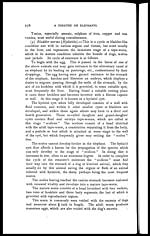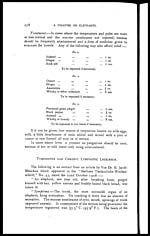Medicine - Veterinary > Veterinary diseases > Elephants and their diseases > Part IV - Non-infective diseases
(337) Page 277
Download files
Individual page:
Thumbnail gallery: Grid view | List view

TYMPANITES. 277
It will be seen from the above that, if the ova of the tape-worm
gain access to the canine stomach, no tape-worm can result, since
it must of a necessity pass through the system of a sheep or kindred
animal and pass through the stage of hydatid cyst.
In the same way, should a scolex find its way into the stomach
of an elephant no hydatid cyst will result, since the scolex must of
necessity pass through the system of a canine animal before again
arriving at this stage.
Elephants therefore cannot directly communicate the parasite to
one another but only indirectly through the media of dogs, wolves,
and jackals.
The dangers of hydatid cyst are—
(a) It may increase and rupture.
(b) It may suppurate and become an abscess.
On the other hand it may rarely be absorbed and disappear.
Treatment : Preventive.—It follows from the above that mahouts
should not be allowed to keep dogs about elephant standings
and, should dogs' droppings about the standings be discovered, they
should be collected and burned.
When diseased liver and lungs are discovered after death they
should be treated likewise.
TYMPANITES.
Definition.—The formation and accumulation of an abnormal
amount of gas in the stomach or bowels.
Causes.—It may simply be due to the fermentation of food as in
cases of simple indigestion. Occasional attacks may be met with
in animals whose digestion is much impaired and it occurs in flatu-
lent colic. It however is met with as a symptom in very grave
conditions, such as impaction, inflammation or twist of the bowels,
peritonitis, etc., and in such cases it is usually regarded as a very
unfavourable sign. Simple tympanites may be distinguished from
the graver diseases in which it may occur by the state of the pulse,
temperature, and injection of the membranes, also the fact that it
usually is seen later on in the course of these diseases.
Symptoms.—Evidence of pain, which may be intermittent or
continuous and sometimes violent. Considerable distension of the
abdominal cavity causing a tense drum-like condition of its walls,
most noticeable in the flanks, often great distress in breathing. The
animal may stand very quiet, but in some cases may be semi-delirious.
Pain on pressure of the abdomen. Sometimes there is passage of
wind.
Set display mode to: Large image | Zoom image | Transcription
Images and transcriptions on this page, including medium image downloads, may be used under the Creative Commons Attribution 4.0 International Licence unless otherwise stated. ![]()
| India Papers > Medicine - Veterinary > Veterinary diseases > Elephants and their diseases > Non-infective diseases > (337) Page 277 |
|---|
| Permanent URL | https://digital.nls.uk/75193071 |
|---|




